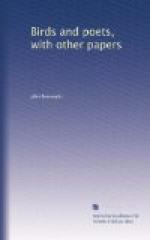I used to mount the ladder to within two or three feet of the nest and observe the proceedings. I at first thought the workshop must be inside,—a place where the pulp was mixed, and perhaps treated with chemicals; for each hornet, when she came with her burden of materials, passed into the nest, and then, after a few moments, emerged again and crawled to the place of building. But I one day stopped up the entrance with some cotton, when no one happened to be on guard, and then observed that, when the loaded hornet could not get inside, she, after some deliberation, proceeded to the unfinished part and went forward with her work. Hence I inferred that maybe the hornet went inside to report and to receive orders, or possibly to surrender her material into fresh hands. Her career when away from the nest is beset with dangers; the colony is never large, and the safe return of every hornet is no doubt a matter of solicitude to the royal mother.
The hornet was the first paper-maker, and holds the original patent. The paper it makes is about like that of the newspaper; nearly as firm, and made of essentially the same material,—woody fibres scraped from old rails and boards. And there is news on it, too, if one could make out the characters.
When I stopped the entrance with cotton, there was no commotion or excitement, as there would have been in the case of yellow-jackets. Those outside went to pulling, and those inside went to pushing and chewing. Only once did one of the outsiders come down and look me suspiciously in the face, and inquire very plainly what my business might be up there. I bowed my head, being at the top of a twenty-foot ladder, and had nothing to say.
The cotton was chewed and moistened about the edges till every fibre was loosened, when the mass dropped. But instantly the entrance was made smaller, and changed so as to make the feat of stopping it more difficult.
IV
There are those who look at Nature from the standpoint of conventional and artificial life,— from parlor windows and through gilt-edged poems,—the. sentimentalists. At the other extreme are those who do not look at Nature at all, but are a grown part of her, and look away from her toward the other class,—the backwoodsmen and pioneers, and all rude and simple persons. Then there are those in whom the two are united or merged,—the great poets and artists. In them the sentimentalist is corrected and cured, and the hairy and taciturn frontiersman has had experience to some purpose. The true poet knows more about Nature than the naturalist because he carries her open secrets in his heart. Eckermann could instruct Goethe in ornithology, but could not Goethe instruct Eckermann in the meaning and mystery of the bird? It is my privilege to number among my friends a man who has passed his life in cities amid the throngs of men, who never goes to the woods or to the country, or hunts or fishes, and yet he is the true naturalist. I think he studies the orbs. I think day and night and the stars, and the faces of men and women, have taught him all there is worth knowing.




